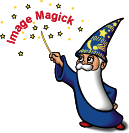

images/aquarium.miff 640x480 PseudoClass 256c 308135b MIFF 1sIf -verbose is set, expect additional output including any image comment:
Image: images/aquarium.miff class: PseudoClass colors: 256 signature: eb5dca81dd93ae7e6ffae99a5275a53e matte: False geometry: 640x480 depth: 8 bytes: 308135 format: MIFF comments: Imported from MTV raster image: aquarium.mtv
Image pixels are stored in memory until 80 megabytes of memory have been consumed. Subsequent pixel operations are cached on disk. Operations to memory are significantly faster but if your computer does not have a sufficient amount of free memory you may want to adjust this threshold value.
This option specifies an image density when decoding a PostScript or Portable Document page. The default is 72 dots per inch in the horizontal and vertical direction. This option is used in concert with -page.
Use this option to print information about the image in a format of your choosing. You can include the image filename, type, width, height, or other image attributes by embedding special format characters:
%b file size %c comment %d directory %e filename extention %f filename %h height %i input filename %l label %m magick %n number of scenes %o output filename %p page number %q quantum depth %s scene number %t top of filename %u unique temporary filename %w width %x x resolution %y y resolution \\n newline \\r carriage returnFor example,
-format "%m:%f %wx%h"
Use this option to specify the width and height of raw images whose dimensions are unknown such as GRAY, RGB, or CMYK. In addition to width and height, use -size to skip any header information in the image or tell the number of colors in a MAP image file, (e.g. -size 640x512+256).
For Photo CD images, choose from these sizes:
192x128 384x256 768x512 1536x1024 3072x2048
This information is printed: image name; the image class (DirectClass or PseudoClass); the total number of unique colors; whether there is a matte associated with the image; the number of runlength packets; the image size; the depth of the image; the image format; the image scene; and finally any image comment. Refer to miff for a description of the image class.